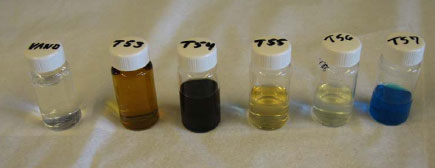Survey and health assessment of chemical substances in jewelleries
5 Benzidine analysis of textile necklaces
- 5.1 Results of the screening
- 5.2 Selection of textile necklaces for benzidine analysis
- 5.3 Analysis method
- 5.4 Results of the analysis
All together 62 textile necklaces were bought. The necklaces were subsequently screened in order to identify a potential content of easily soluble dyes. Azo-dyes are characterized by being easily soluble. The screening was performed by lowering the textile necklaces in water (40 degrees) for a period of 4 hours. Coloured extracts in the water are an indication of a possible content of azo-dyes which can form aromatic amines (among these benzidine) by degradation. During the test none of the textile necklaces were destroyed, since only a part of the textile necklace was lowered in the water. Though, in a few cases, it could not be avoided that the pendant as well was in contact with the water.
5.1 Results of the screening
The results of the screening test can be seen in Appendix I which contains the following information related to each textile necklace:
- Colouring of the water (1= yes; 0 = no)
- Shade of colour
- Degree of colouring (1 = weak; 2 = medium; 3 = strong)
55 of the 62 examined textile necklaces resulted in colouring of the water. Of these 27, which corresponds to approximately 44% of the examined textile necklaces, showed a strong colouring.
| Degree of colouring | Number of textile necklaces |
| No colouring | 7 |
| Week colouring | 15 |
| Medium colouring | 13 |
| Strong colouring | 27 |
| Total | 62 |
In a few cases the relatively small piece of necklace string was able to dye the water pitch-black during the 4 hour period (se figure below).

The distribution of the colourings according to number of necklaces can be seen below:
| Colouring | Number of textile necklaces |
| Turquoise | 2 |
| Black | 6 |
| Red/brown | 1 |
| Red | 8 |
| Orange | 1 |
| Dark green | 1 |
| Purple | 1 |
| Yellow | 16 |
| Green | 5 |
| Brown, blurred | 1 |
| Brown | 5 |
| Blue | 8 |
| Total | 55 |
5.2 Selection of textile necklaces for benzidine analysis
No obvious selection criteria were available, since one cannot rank a strong colouring alongside a bigger ”chance” of finding azo-dyes.
Furthermore, azo-dyes come in a variety of colours, thus a selection based on a certain shade of colour, is likewise not a reliable selection method.
Thus, the only selection criterion was to select textile necklaces which represented different shades of colours.
The 10 selected textile necklaces are presented in the table below.
Table 5-1: textile necklaces selected for benzidine analysis
| Textile necklace no. | Shade of colour detected during the screening |
| T6 | Black |
| T7 | Turquoise |
| T24 | Blue |
| T25 | Orange |
| T40 | Red |
| T44 | Black |
| T53 | Brown |
| T55 | Yellow |
| T59 | Red |
| T62 | Green |
5.3 Analysis method
The analysis for potential content of benzidine produced by reduction of one or more azo-dyes was conducted according to EN 14362-1:2003: extraction of colour in citric acid buffer, reduction by natrium dithionite, purification on column (Merck Extralut), extraction from column by methyl tert-butyl ether, concentration by means of heating and re-dissolvation in solvent (MTBE). Subsequently the extract was analysed for content of benzidine by GCMS. Duplicate determinations were performed for all samples besides sample no. T24, which was so small (180 mg) that duplicate determination was not possible. The detection limit related to sample no. T24 is thus larger (2 mg/kg). Five of the samples did not include enough textile string to perform duplicate determination based on extraction from 1g (as the standard prescribes), thus duplicate determinations were performed by extracting from approximately 0.5 g.
5.4 Results of the analysis
Two of the ten textile necklaces had a content of benzidine of 100 and 1200 mg/kg respectively, thus far above the permitted content of 30 ppm. The results can be seen in the table below. For samples marked with ”≤1 mg/kg” no signal for benzidine was observed.
Table 5-2: Results of the benzidine analysis of the 10 textile necklaces.
| Textile necklace no. | Benzidine (mg/kg) |
| T6 | ≤1 |
| T7 | ≤1 |
| T24 | ≤2 |
| T25 | ≤1 |
| T40 | ≤1 |
| T44 | ≤1 |
| T53 | 100 |
| T55 | ≤1 |
| T59 | 1200 |
| T62 | ≤1 |
The concentration of benzidine was determined by external calibration based on a solution with 1000 mg/l. This was done because the two samples, which showed a content of benzidine, had a content well above 10 mg/l.
Version 1.0 October 2008, © Danish Environmental Protection Agency